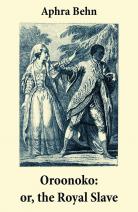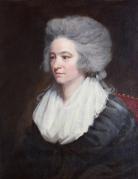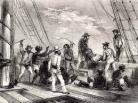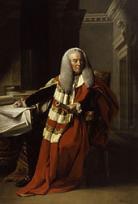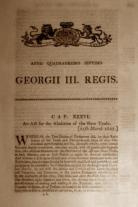A History of Mary Prince
Created by Erin Garrett on Fri, 09/24/2021 - 16:17
A timeline of events related to Mary Prince and the relevance of her story to the Gothic tradition.
Timeline
Chronological table
| Date | Event | Created by | Associated Places | |
|---|---|---|---|---|
| circa. 1670 |
Aphra Behn travels to SurinamAs a young woman, Behb accompanies her mother and siblings to the French colony of Surinam, modern Guiana, where she based her later text Oroonoko. |
Erin Garrett | ||
| circa. 1688 |
Aphra Behn's Oroonoko or, the Royal Slave. A true history.Aphra Behn's Oroonoko is one of the earliest examples of the novel genre. Originally published in 1688, this novel employs the first person narritve voice from a female perspective while also working to examine some of the most controversial issues of the 17th century. Through Behn's account of the realities of life in the English colonies in North America, she exposes the horrors of the transatlantic slave trade. This novel also is credited with the begining of the "noble savage" trope. While in the present day this theme is now understood to be a deeply racist view point, in the later part of the 18th centry it was recognized as being a literary concept which lent to for the abolition of slavery. “Aphra Behn's Oroonoko, 1688.” The British Library, The British Library, 5 Dec. 2017, www.bl.uk/collection-items/aphra-behns-oroonoko-1688 |
Katie Jackson | ||
| 2 Feb 1745 to 7 Sep 1833 |
Hannah MoreHannah More was born on February 2, 1745, in Gloucestershire, England. She was not only an English religious writer and philanthropist, but she was also an educator. Her most famous works include Thoughts on the Importance of the Manners of the Great to General Society and The Sorrows of Yamba. More was also a playwright who wrote about moral and religious subjects. In the 1770s, she made frequent visits to London, where she met William Wilberforce, an abolitionist philanthropist. Here stemmed her interest in the Evangelicals. During the French Revolution, her voice calling to change traditional values had a powerful impact and approval. More was able to recognize that society was not only static but acknowledge that their civilization was dependent on the large population of the poor. Later on in the 1790s, Hannah More wrote Cheap Repository Tracts which discussed moral, political and religious issues that should be shared with the poor. She was also able to establish clubs for women and schools for children despite the heavy amount of abuse and opposition by country neighbors who, in turn, believed that if the poor were to be educated, they would stray away from the clergy and their farming duties. “Hannah More.” Encyclopædia Britannica, Encyclopædia Britannica, Inc., 29 Jan. 2021, www.britannica.com/biography/Hannah-More.
|
Sophia Trejo | ||
| 29 Nov 1781 to 1783 |
The Zong Massacre and Slavery AbolishmentIn the Romantic period, which lasted from 1780-1837, slavery was a common thing among the nation of Europe. Amid this period, anti-slavery was able to arise towards the early 1800’s by many activists had great success in accomplishing their goals, helping abolish slavery. Before the abolishment happened, Britain was responsible for transporting millions of enslaved Africans across the Atlantic Ocean and being heavily involved with slavery. In the fall of 1781, Caption Luke Collingwood took himself, his crew and over 400 slaves to voyage from Africa to Jamaica. During this voyage a horrific event took place, the event was named The Zong Massacre because of the ship that it took place on was named Zong. Collingwood overloading the ship with crew members and salves, which was not an uncommon thing for captions to do to make more profit for one trip. While on the water many crew members and slaves developed an illness. This illness was responsible for 17 crew members and over 50 salves deaths. Frantic to make profit from who was left, on 29th of November in the same year, Luke Collingwood threw slaves over 130 salves into the water because of their illness to prevent further spread and therefore lowering his profit. Collingwood's plan was to put a claim in to the insurance to make up for what they loss in human lives but to him it was “goods and property”. Collingwood stated “what is this claim that human people have been thrown overboard? This is a case of chattels or good. Blacks are goods and property; it is madness to accuse these well-serving honorable men of murder… the case is the same as if wood had been thrown overboard.” After a case was issued for this massacre that occurred on Zong. This case was developed because of Great Britain’s lead activist at the time, Grantsville Sharp, wanted to draw attention to this event to raise awareness for the anti-slavery movement. Sharp pressed charges against Zong’s owners and caption and the case reached the highest court in Great Britain. Unfortunately, the court favored the insurers and Collingwood got a slap on the wrist for not having enough water for everyone on board of the ship. In the end, no one took reasonability for the Zong massacre or was brought to justice of the lives who were thrown overboard. The transported slaves were treated at "cargo" and nothing more. Collingwood called it "madness" to be charged for throwing men overboard and killing them, because he did not see the slaves as human people. Eventually, actions were taken by the anti-slavery movement through successful campaigns to abolish slavery throughout the British Empire in 1833. Bernard, I. (2020, July 29). The Zong Massacre (1781) •. Black Past. Retrieved September 20, 2021, from https://www.blackpast.org/global-african-history/zong-massacre-1781/. Oldfield, J. (2021, February 4). Abolition of the Slave Trade and Slavery in Britain. British Library. Retrieved September 20, 2021, from https://www.bl.uk/restoration-18th-century-literature/articles/abolition-of-the-slave-trade-and-slavery-in-britain.
|
Bri Thomas | ||
| circa. 1783 |
The Zong TrialThe captain continuously claimed insurance on the slaves, claiming that he was doing it in an effort to save the remaining slaves and crew onboard. A trial took place in 1783, to discuss the matter of insurance. This trial was found in favor of the slavers, yet the insurers sought a second trial and brought the issue to Lord Mansfield, the Chief Justice. Lord Mansfield decided on a retrial because he thought that the captain and the crew of the Zong were at fault. There was never a retrial, and the slavers never got paid or insured for the murder of the slaves. The Zong massacre and the Zong trial were significant influence and spark for the abolitionist movement. An anti-slaver and aboliionist Granville Sharp, used the trial and massacre to help the movement and increase awareness. |
Jordan Larson | ||
| 5 May 1789 to 10 Nov 1799 |
French Revolution
On 5 May 1789, the Estates-General, representing the nobility, the clergy, and the common people, held a meeting at the request of the King to address France’s financial difficulties. At this meeting, the Third Estate (the commoners) protested the merely symbolic double representation that they had been granted by the King. This protest resulted in a fracture among the three estates and precipitated the French Revolution. On 17 June, members of the Third Estate designated themselves the National Assembly and claimed to represent the people of the nation, thus preparing the way for the foundation of the republic. Several pivotal events followed in quick succession: the storming of the Bastille (14 July), the approval of the Declaration of the Rights of Man and of the Citizen (26 August), and the march on Versailles that led to the enforced relocation of the royal family to Paris (5-6 October). These revolutionary acts fired the imagination of many regarding the political future of France, and, indeed, all of Europe. The republican period of the revolution continued in various phases until 9-10 November 1799 when Napoleon Bonaparte supplanted the government. ArticlesDiane Piccitto, "On 1793 and the Aftermath of the French Revolution" |
Dave Rettenmaier | ||
| 1807 |
British slave trade outlawedSlave trade outlawed (but not slavery itself) |
Stacey Kikendall | ||
| circa. 25 Summer 1807 to circa. 1833 |
Abolition of Slave-TradeAccording to the British Library Organization, "In 1807, the British government passed an Act of Parliament abolishing the slave trade throughout the British Empire. Slavery itself would persist in the British colonies until its final abolition in 1838" (par. 1). Citation? |
Carmen Flores-Lopez | ||
| 1823 |
Anti-Slavery SocietyMary Prince worked for the Anti-Slavery Society which was founded in 1823. At the time of its founding the slave trade was outlawed in Britian but slavery itself was not outlawed. The society and Mary Prince was integral in their work to outlaw slavery all together. Slavery was outlawed in 1833 unfortunatley the same year Mary Prince died. |
Brandon Walker | ||
| 1831 |
A History of Mary PrinceStory by Mary Prince, transcribed by Suzanna Strickland, edited by Thomas Pringle |
Stacey Kikendall | ||
| Summer 1832 |
Reform Act of 1832An act meant to take effectual measures for correcting divers Abuses that have long prevailed in the choice of members to serve in the commons house of parliament. Also opening the door for abolitionists and dissenters to the idea of slavery and child labor. |
Madison Beckstrand | ||
| The end of the month Aug 1833 |
Slavery Abolition Act of 1833Before one can understand the importance of the Slavery Abolition Act of 1833, an understanding of how the act came into effect must be acknowledged. The two main political parties at this time in England were the Whigs and the Tories. The Whigs were tied to political liberalism and attached to constitutional monarchy and the rights of Parliament. To sum up the political party, they were for electoral reform. The Tories were opposed to reform. They supported traditional traditional political and social institutions, meaning that they were for the monarchy, nobles, and gentry. To summarize a long history of political parties squabbling for power, the Whigs came back to power during the 1830's. They unified as a political party on the basis of moral reform, specifically, the abolition of slavery. They also campaigned on the horrors of child labor and relief to the poor. Other Acts were passed around the same time as the Slavery Aboliton Act. The Poor Law Amendment Act of 1834 was passed and limited reforms were passed in relation to child labor. So how did many radical changes to Parliament happen in such a short time? The radical change is thanks to The Reform Act of 1832. What this act basically did was take power away from aristocracy. Before the act, elections were controlled by high ranking, very powerful families. The act distributed voting power based on population, adding many new upper and middle class voters to the voting pool. This act gave an immense amount of power to the people. So what did the Slavery Aboliton Act do and what is its importance? The Slavery Aboliton Act abolished slavery in all parts of the British empire. More importatly it made the ownership of slaves illegal. However, it didn't make slavery illegal in parts of the British empire that made a lot of money for Britain. The area that still allowed slavery was the East India Company, the countries Ceylon (modern day Sri Lanka) and Saint Helena. The Slavery Abolition Act was important because it purchased and freed the slaves currently in captivity, mainly in the Caribbean Sugar Islands. The act was also important because it expanded on the The Slave Trade Act of 1807 and was a success for the growing abolitionist movement and the majority of the people (middle and lower class) in government. Showing that they could and would exercize their right to change parliament and take power away from the aristocracy. Slavery Abolition Act 1833. (2020, September 24). Retrieved October 05, 2020, from https://en.wikipedia.org/wiki/Slavery_Abolition_Act_1833 Whigs (British political party). (2020, September 24). Retrieved October 05, 2020, from https://en.wikipedia.org/wiki/Whigs_(British_political_party) Tories (British political party). (2020, August 29). Retrieved October 05, 2020, from https://en.wikipedia.org/wiki/Tories_(British_political_party) Poor Law Amendment Act 1834. (2020, August 20). Retrieved October 05, 2020, from https://en.wikipedia.org/wiki/Poor_Law_Amendment_Act_1834 Reform Act 1832. (2020, October 02). Retrieved October 05, 2020, from https://en.wikipedia.org/wiki/Reform_Act_1832 Slave Trade Act 1807. (2020, September 28). Retrieved October 05, 2020, from https://en.wikipedia.org/wiki/Slave_Trade_Act_1807 |
Thomas Wrenn | ||
| Oct 1865 |
Morant Bay RebellionAlthough slavery was abolished in the British West Indies in 1838, black Jamaicans still felt oppressed being pushed to work for low wages and still primarily under the control of the wealthy white owners of land. In October 1865, sometime after Queen Victoria’s unfavorable response to the Jamaicans’ petition, Paul Bogle led protests against the court settlement of a land dispute. In what became known as the Morant Bay Rebellion, Bogle marched on the courthouse and was met by the response of the soldiers killing hundreds of the rebels. Edward Eyre, the governor of the colony, ordered the arrest of Bogle’s political mentor, George William Gordon. Governor Eyre abused martial law to hang Gordon without the burdens of proof in civilian court. This response to the rebellion divided Britain. John Stuart Mill became chairman of the Jamaican Committee and raised money for a private prosecution against Eyre for what they deemed as the “murder” of Gordon. Thomas Carlyle became the chairman of the Eyre Defence Fund to raise the money for Eyre’s legal representation. The prosecution of the governor failed, but his reputation was tarnished and he lived in private. Source: “Jamaica's Morant Bay Rebellion: Brutality and Outrage in the British Empire.” HistoryExtra, November 26, 2020. https://www.historyextra.com/period/victorian/jamaicas-morant-bay-rebell.... |
DeShawn Thompson |

